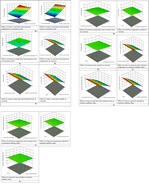Utilization of quince (Cydonia oblonga) seeds for production of mucilage: functional, thermal and rheological characterization
Abstract
The need for food hydrocolloids with specialized functions is now being widely studied. Plant-derived hydrocolloids have a larger advantage over synthetic ones because they have a more pleasant image with customers. Quince seed mucilage (QSM) is one source and plays an essential role in the food sector. The current research was undertaken for the valorization of quince seed waste for the production of mucilage and characterization of its functional, thermal, and rheological parameters. Extraction conditions such as water to seed (W/S) ratio (14.5 : 1 to 44.5 : 1), extraction temperature (30 to 60 °C), extraction time (10–30 min), and pH (5 to 9) for maximum values of extraction yield (EY), viscosity and emulsion stability index (ESI) of QSM were investigated using response surface methodology-central composite rotatable design. Data analysis showed that independent variables significantly influenced all quality parameters. For all responses, the regression models showed a higher coefficient of determination (R2 ≥ 0.99). The optimum extraction conditions, viz., pH, extraction temperature, extraction time, and W/S ratio, determined by numerical optimization were 9, 60 °C, 15 min, and 19 : 1, respectively. Under these optimum conditions, EY, viscosity, and ESI were 16.17%, 1143.22 mPa s, and 84.62 min, respectively. The results indicated that the mucilage obtained exhibited high water holding capacity and adequate oil holding capacity. Thermal analysis of the mucilage was done with DSC, which showed that QSM was a thermostable hydrogel. Rheometry data depicted that storage modulus was more than loss modulus and both of them increased with an increase of frequency.

- This article is part of the themed collection: Sustainable Food Technology – Editors Choice Collection 2023


 Please wait while we load your content...
Please wait while we load your content...